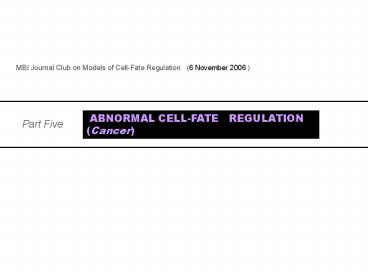ABNORMAL CELLFATE REGULATION Cancer
1 / 25
Title:
ABNORMAL CELLFATE REGULATION Cancer
Description:
MBI Journal Club on Models of Cell-Fate Regulation. Important elements of the model: ... the different cell types only differ in their physical properties ... –
Number of Views:37
Avg rating:3.0/5.0
Title: ABNORMAL CELLFATE REGULATION Cancer
1
(6 November 2006 )
MBI Journal Club on Models of Cell-Fate Regulation
ABNORMAL CELL-FATE REGULATION (Cancer)
Part Five
2
(No Transcript)
3
(No Transcript)
4
Important elements of the model
? Cell proliferation growth ? Nutrient
consumption diffusion ? Waste production
diffusion ? Effects of growth-promoting
-inhibitory factors ? Intercellular adhesion ?
Cell-environment interactions ? Geometry of the
cells
5
Cellular scale
discrete lattice Monte Carlo model of cell
growth proliferation, intercellular
adhesion, necrosis
Discrete lattice Monte Carlo model partitions 3D
space into domains of cells and cell medium.
Each cell with a unique ID. A cell has a finite
volume and a deformable shape. A typical cell
occupies 27 lattice sites.
Cells have direct contact and interact with each
other through surface adhesion and competition
for space.
(necessary for cell sorting)
Total energy of cell-cell interactions
6
Cell types - proliferating -
quiescent - necrotic - medium
the different cell types only differ in their
physical properties (cell-cycle duration,
metabolic rates, cell adhesion, and maximum
volume). External culture medium and the
necrotic core are treated as special cells.
Medium does not have a target volume thus
proliferating cells can invade the external
space when they grow. A necrotic cellhas a
target volume set to its current volume, and a
large g value corresponding to a rigid body.
Thus, its space cannot be invaded by the growing
mass of viable tumor cells. Every time a cell
dies, its volume is added to the target volume of
the necrotic core. model does not consider
apoptosis
7
Monte Carlo procedure A random lattice site is
selected the cell ID at this site is changed to
the value of one of its unlike neighbors ID.
The probability of accepting such a change is
8
Extracellular scale
diffusion, consumption, production of
nutrients, metabolites growth promoters and
inhibitors (ODEs)
includes nutrients (oxygen and glucose),
metabolic waste, growth promoters, and
inhibitors. consider that the main waste
in the tumor is the lactate, and that lactate
production is 1.5 times the glucose
consumption rate.
9
(No Transcript)
10
(No Transcript)
11
Subcellular scale
Boolean protein regulatory network for control
of cell cycle
the cells in their G1-phase have the highest
probability of becoming quiescent.
Simplified protein regulatory network to control
the G1-S transition
These proteins have only 2 levels on or off
(boolean network)
Note this is a bad control network for the G1
checkpoint I have a better one! - Baltz
12
(No Transcript)
13
SIMULATION
14
The tumor growth starts from a single tumor cell
in the center of the lattice with its first set
of proteins turned on (top tier in Fig 2).
15
Update cell numbers (evolve the cell
lattice) Cells identified according to 16
cell-cycle stages (12 h) G1 6 stages S
6 stages G2/M 4 stages Cells double
volume in 4 MCS (Monte Carlo Step) ¼ MCS
duration of one cell-cycle stage ¾
h
16
Solve the following equations to determine
the metabolite concentrations per
cell
17
For cells during G1 phase, the local factor
levels change the expression of proteins in the
regulatory network.
18
(No Transcript)
19
(No Transcript)
20
(No Transcript)
21
RESULTS
22
(No Transcript)
23
(No Transcript)
24
(No Transcript)
25
(No Transcript)































